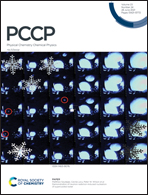A benchmark ab initio study of the complex potential energy surfaces of the OH− + CH3CH2Y [Y = F, Cl, Br, I] reactions†
Abstract
We provide the first benchmark characterization of the OH− + CH3CH2Y [Y = F, Cl, Br, I] reactions utilizing the high-level explicitly-correlated CCSD(T)-F12b method with the aug-cc-pVnZ [n = 2(D), 3(T), 4(Q)] basis sets. We explore and analyze the stationary points of the elimination (E2) and substitution (SN2) reactions, including anti-E2, syn-E2, back-side attack, front-side attack, and double inversion. In all cases, SN2 is thermodynamically more preferred than E2. In the entrance channel of SN2 a significant front-side complex formation is revealed, and in the product channel the global minimum of the title reactions is obtained at the hydrogen-bonded CH3CH2OH⋯Y− complex. Similar to the OH− + CH3Y reactions, double inversion can proceed via a notably lower-energy pathway than front-side attack, moreover, for Y = I double inversion becomes barrier-less. For the transition state of the anti-E2, a prominent ZPE effect emerges, giving an opportunity for a kinetically more favored pathway than back-side attack. In addition to SN2 and E2, other possible product channels are considered, and in most cases, the benchmark reaction enthalpies are in excellent agreement with the experimental data.
![Graphical abstract: A benchmark ab initio study of the complex potential energy surfaces of the OH− + CH3CH2Y [Y = F, Cl, Br, I] reactions](/en/Image/Get?imageInfo.ImageType=GA&imageInfo.ImageIdentifier.ManuscriptID=D1CP01303C&imageInfo.ImageIdentifier.Year=2021)
- This article is part of the themed collection: 2021 PCCP HOT Articles


 Please wait while we load your content...
Please wait while we load your content...